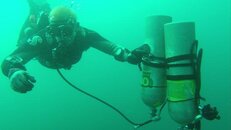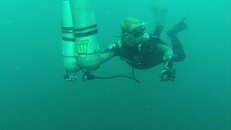DevonDiver
N/A
I obviously have a much smaller sample set than you but this was in response to being able to "disconnect 1 tank as you approach the boat" which requires manipulation of more than just the boltsnaps underwater.
Boltsnaps and bungee. I drill cylinder handling on my courses - I think the muscle memory /equipment familiarity is worth developing. It is, after all, an equipment usage course.


We have lots of fun on the course, especially playing with don/doff cylinder drills at the end of the dive - this also reinforces some good points about diver/cylinder buoyancy etc...
Is backwards kick mandatory for the course? I ask because it took me (and a few others I know) quite few dives to understand how to do this while maintaining a 1-2 foot window since it is not as intuitive as other kicks.
With PADI, it is all about interpretation of standards. It is a standard to demonstrate back kick (and 180 helicopter turn). With the back kick, it's important to note that no distance requirement is given.
For me, I develop the back kick in confined water. Then we have approx 270 minutes of open water time to work on this, and other skills, further. Very few students, from nothing, will develop an awesome back kick in that time... they will have the beginnings of the technique though. As there's no distance requirement, it's not a pass/fail criteria.
Is it common practice to put weights on cylinders for the PADI course? I see that it says “optional”...
I'd guess the practice depends on; (1) the expertise of the instructor and (2) regional diving practices. I couldn't guess how common it is. I see it as a 'quick fix' to tank trim with AL cylinder - so probably more attractive to inexperienced sidemount instructors.
I teach sidemount right up to advanced/technical/overhead levels. For me, AL cylinder weights are a short term option. You wouldn't want cylinder weights in confined environments. So I don't teach it that way ('beginning with the end in mind').
I wanted to get an understanding why the latter option isn’t standard.
PADI typically don't follow a 'beginning with the end in mind' philosophy (although individual instructors might... I do). Also, the scope of options is very wide; reflecting a flexibility for application on a global level under different conditions and with different equipment.
I teach AL cylinder trim via proper configuration, gas management and cylinder positioning (d-rings) as a standard. However, I do inform students of the option to weight tanks - with the caveat of why I don't choose that option personally. Teaching cylinder trim without weights provides a skill-set and understanding (good training)... whether the student chooses to follow that skill-set/understanding post-qualification is their decision. I suspect most of my students do. If I taught cylinder weighting as standard, then students would be deprived the skill-set to sidemount properly without that 'quick-fix'.



